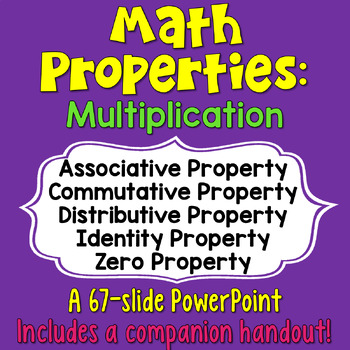Multiplication Properties PowerPoint Lesson with Practice Exercises
- Zip
What educators are saying
Also included in
- This math properties bundle has everything you need to introduce your students to addition properties and multiplication properties. The activities in this math bundle make learning the math properties fun and easy! Students love the activities while teachers love the convenience of these no-prep rePrice $13.00Original Price $19.50Save $6.50
Description
Are you searching for a step-by-step PowerPoint that can be used to introduce common multiplication properties to your students in a way that will grab their attention? You've come to the right place! This 66-slide PowerPoint begins by reviewing the commutative, associative, and identity properties of addition that students have already learned. Students are shown how they can use their prior learning and apply it to the commutative, associative, and identity properties of multiplication. Next, the distributive property and zero property of multiplication are introduced. Each property is connected to an image to aid students in retention. (For example, the commutative property is connected to a commuter train and the identity property is connected to a mirror.) Many practice slides are included!
This 66-slide PowerPoint focuses on the following math properties:
→ Commutative Property of Multiplication
→ Associative Property of Multiplication
→ Identity Property of Multiplication
→ Distributive Property
→ Zero Property of Multiplication
PowerPoints filled with visuals are ideal for teaching new content to students because PowerPoints tend to be highly engaging and concepts can be easily broken down into understandable chunks of information. But let's face it... they are so time-consuming to create! Fortunately, now you have an option of using one that is already complete, kid-tested, and ready to go for you!
HERE'S THE SEQUENCE OF TOPICS COVERED IN THIS POWERPOINT:
Slides 1-2: Introduction
Slides 3-15: Commutative Property of Multiplication
Slides 16-23: Identity Property of Multiplication
Slides 24-36: Associative Property of Multiplication
Slides 37-54: Distributive Property
Slides 55-59: Zero Property of Multiplication
Slides 60-66: Practice slides: Solve the equation and identify the property.
This file also includes a PowerPoint companion handout. Students will remain especially engaged when they write on their own handout as you advance through the PowerPoint. The companion handout is available in both printable format or digital format.
***Click on this link to check out my Math Properties BUNDLE, which includes PowerPoints, worksheets, and sorting activities!***
CHECK OUT THE PREVIEW!
Here's what teachers like you have to say about this math properties PowerPoint:
⭐️ Terry J. said, "This was an excellent resource! My students were engaged and helped them understand multiplication properties. I would definitely recommend this product!"
⭐️ Melissa W. said, "Such a wonderful resource and very comprehensive. I was able to use this as an introductory tool with my students and they loved the animation and how easy it was to follow! Will use this year after year!"
⭐️ Ann T. said, "This resource helped my students understand the concepts of addition and multiplication properties. They were able to remember them better than just talking about the different properties."
⭐️ Teach with Mrs. S. said, "This was exactly what I was looking for. It was user-friendly and my students loved it."
Please note: You DO have my permission to convert this PowerPoint to Google Slides, and to share it with your students via Google Classroom. (A Google link is not provided, but you may upload the PowerPoint to Google yourself, if you wish.)
Also, this PowerPoint cannot be edited due to the copyright requirements made by the contributing artists (clip art, font, background).
Copyright by Deb Hanson
This item is a paid digital download from my TpT store
www.teacherspayteachers.com/Store/Deb-Hanson
This product is to be used by the original downloader only. Copying for more than one teacher is prohibited. This item is also bound by copyright laws. Redistributing, editing, selling, or posting this item (or any part thereof) on an Internet site that is not password protected are all strictly prohibited without first gaining permission from the author. Violations are subject to the penalties of the Digital Millennium Copyright Act. Please contact me if you wish to be granted special permissions!






